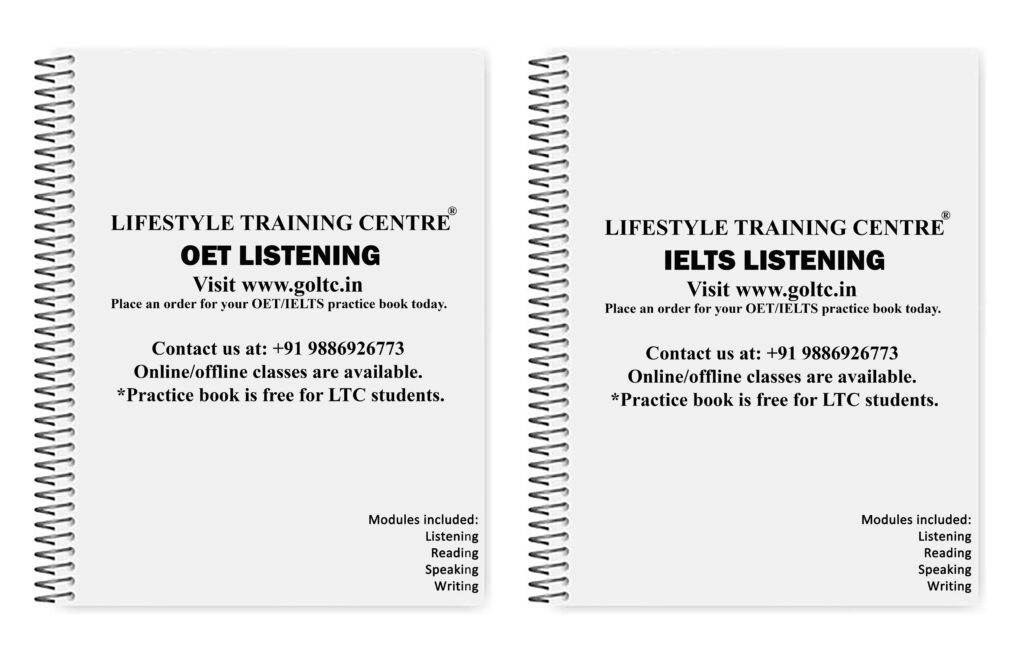OCCUPATIONAL ENGLISH TEST WRITING SUB-TEST: NURSING TIME ALLOWED: READING TIME: WRITING TIME:
5 MINUTES 40 MINUTES
Read the case notes below and complete the writing task which follows.
Notes:
Hospital: Flinders Medical Centre
Patient Details:
Name: Mr Jonathon Singh
Age: 63 years Address: 51 Parsons Road, Woodville West
Marital Status: married
NOK: Mrs Megan Singh ph 0433 917825
Admission date: 22/10/08
Discharge date: 26/10/08
Diagnosis: Carbon monoxide poisoning- home kerosene heater Past
Medical History:
Cataract surgery 12/5/99
Surgical repair for Prostate Hypertrophy 29/9/05
Psoriasis Constipation Impaired vision- glasses
Social History /Supports:Retired bank employee- Commonwealth Bank Lives with wife and adopted daughter- both overseas at present
Day 1- 22/10/08/ On examination: widely dilated pupils Unconscious Cold clammy skin, cherry red lips and skin Dyspnoea Physical examination. Assessed for head injury or other Precipitating factors causing coma- negative result. Blood test for blood sugar to ? diabetic coma- negative result.
Treatment: 0₂ Sats at 98% on 2 L/min via nasal specs Hyperbaric oxygenation Hourly assessment of vital signs Calm environment NG tube inserted for feeding Monitored for asphyxia Registrar visit 2pm Knees flexed using pillows Foot board to prevent foot drop Pressure Area Care: frequent change in position and back rub In- dwelling catheter Skin care for psoriasis
Observation:Patient comatose, but no other physical injuries. No asphyxia
Day 2- 23/10/08 Treatment:0₂ Sats at 98% on 2 L/min via nasal specs Hyperbaric oxygenation ceased at 1900 Hourly assessment of vital signs Calm environment NG tube Skin specialist assessment re psoriasis Skin care for psoriasis Foot board to prevent foot drop Pressure Area Care: frequent change in position and back rub. Skin intact IDC draining moderate amounts
Observation:Patient regained consciousness with right hemi-plegia 1800
Day 3- 24/10/08 Treatment: Assessment for consciousness GCS 14 but varies Hourly assessment of vital signs Calm environment Good ventilation NG tube removed- liquid diet per oral Mobility assessment Right sided weakness Speech affected, vision as per normal for this patient Small pillow placed on affected right side for prevention of adduction of arm Physiotherapist assessment and commencement of passive exercises Pressure Area Care: frequent change in position and back rub Removal of IDC
Observation:Level of consciousness with right-sided weakness. Comfortable, depressed and anxious re prognosis
Days 4- 25/10/08 Treatment:Assessment for conscious GCS 15 2 Hourly assessment of vital signs Physiotherapist visit- passive exercise continued Range of motion gradually increased Pressure Area Care: patient encouraged to move off sacrum as it is a little red Full ward diet and fluids
Observation:Patient mentally stable, but depressed. Making steady physical progress. Doctor has advised discharged tomorrow and further rehabilitation at The General Repatriation Hospital
Nursing Management: Provided comfortable stable environment Output, skin integrity, diet monitored Assistance in regaining physical health.
Discharge plans:Daily assessment and support from physiotherapist and possibly occupational therapist for increased mobility and physical ability Psychiatrist visits to be initiated regarding depression caused by loss of mobility and independence following the accident
Writing Task:Write a letter of referral to the Director, General Repatriation Hospital, Daw Park, using the information above.
In your answer:Expand the relevant case notes into complete sentences Do not use note form Use letter format. The body of the letter should be approximately 180-200 words.
Sample answer by Lifestyle Training Centre
Director,
General Repatriation Hospital,
Daw Park
26/10/08
Dear Sir/Madam,
Re: Mr Jonathon Singh, aged 63 years.
I am writing to refer Mr Singh who requires rehabilitative care and management at your hospital, following his discharge today. He is currently recovering from Carbon monoxide poisoning out of a home kerosene heater.
Mr Singh was admitted to our hospital on 22/10/08 unconscious, with cherry red lips and cold and clammy skin. He suffered from Dyspnoea; his pupils were widely dilated.
During hospitalization, he underwent Hyperbaric oxygenation and was monitored for asphyxia. He had initially required in-dwelling catheter and was fed using NG tube. He was provided Pressure Area Care and skin care for psoriasis.
On 24/10/08, Mr Singh regained consciousness with right hemi-plegia. He was commenced on passive exercises after physiotherapy assessment, which has improved his range of motion. He has right sided weakness, and his speech is impaired. Pillows were used to prevent his arm adduction. He was commenced on full ward diet and fluids.
Mr Singh is a retired bank employee, and his wife and adopted daughter live overseas at present. You can reach his NOK, Mrs Megan Singh, on 0433-917825 if required.
Although Mr Singh is now mentally stable and making steady physical progress, he is depressed, owing to his physiological state. Therefore, please arrange psychiatrist visits for him. In order to improve his mobility and functionality, he also requires daily assessment and support of a physiotherapist and occupational therapist.
Should you have further queries, please do not hesitate to contact me.
Yours faithfully,
Registered Nurse
(Word count: 224)
Submit your OET letters for correction: (for a minimal fee)
https://goltc.in/oet-writing-correction/
We hope this information has been valuable to you. If so, please consider a monetary donation to Lifestyle Training Centre via UPI. Your support is greatly appreciated.

Would you like to undergo training for OET, PTE, IELTS, Duolingo, Phonetics, or Spoken English with us? Kindly contact us now!
📱 Call/WhatsApp/Text: +91 9886926773
📧 Email: [email protected]
Visit us in person by following the directions on Google Maps. We look forward to welcoming you to the Lifestyle Training Centre.
Follow Lifestyle Training Centre on social media:
Thank you very much!



























































